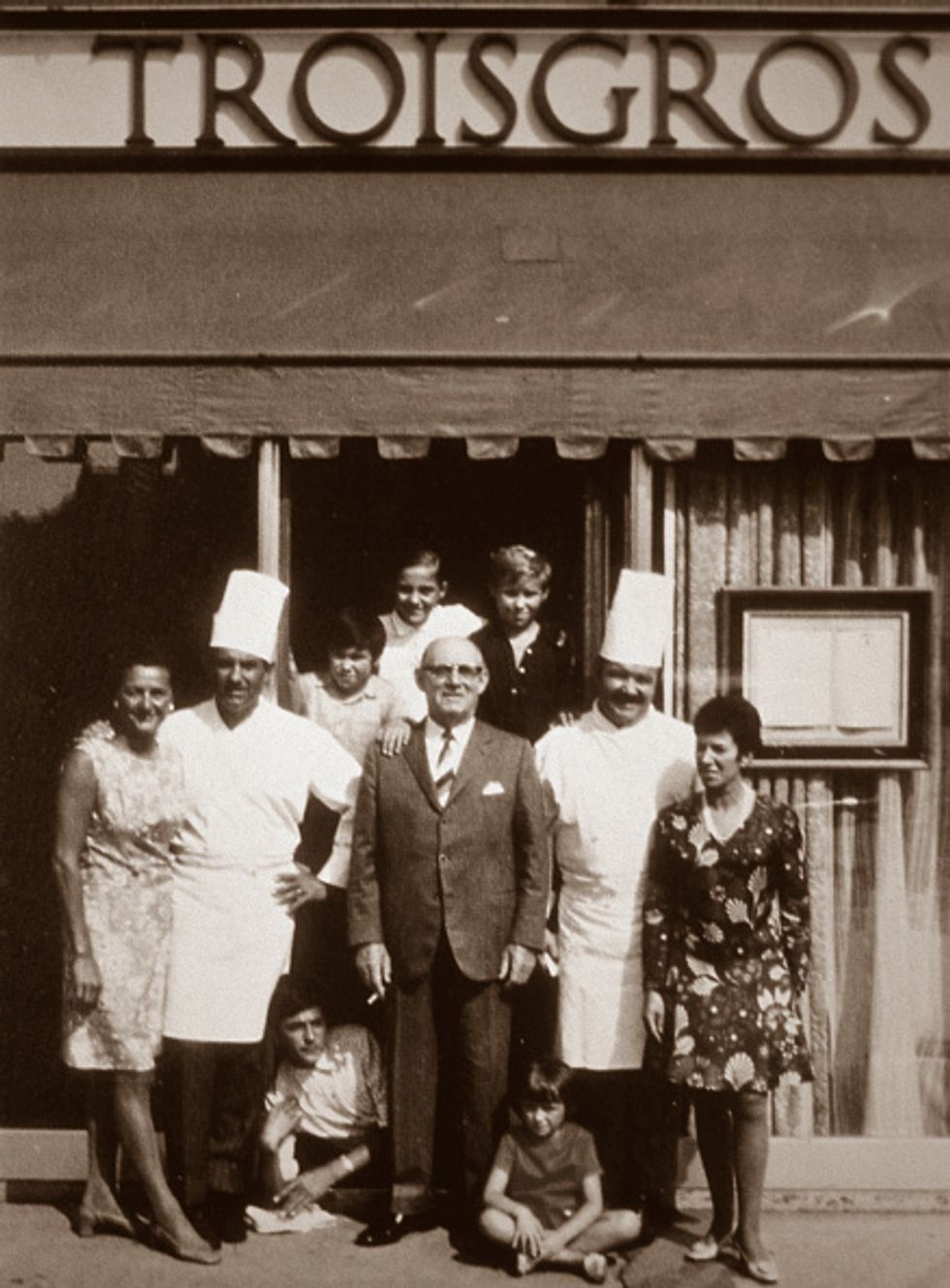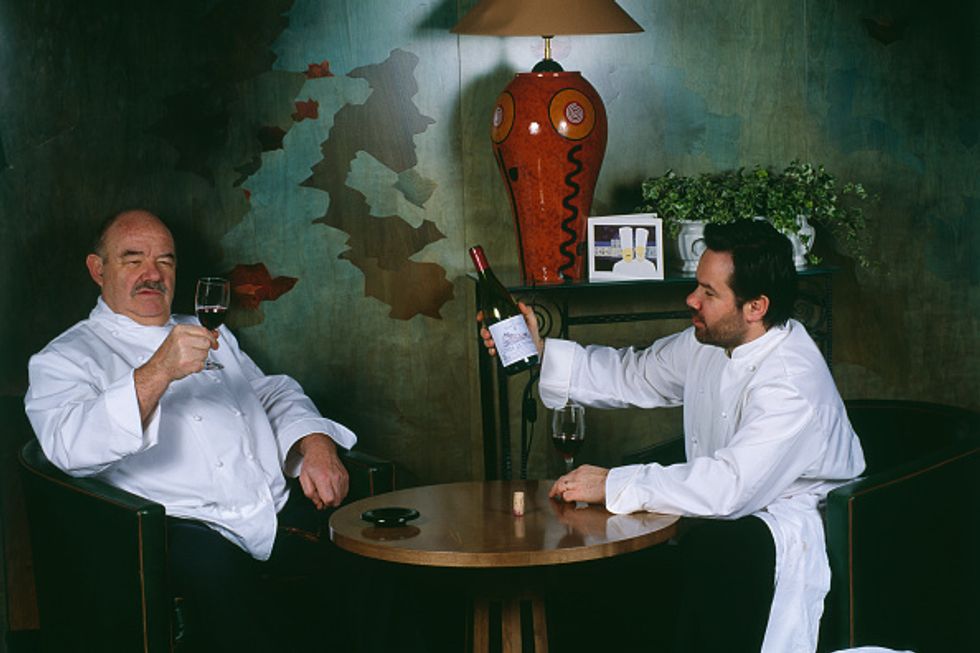Dan Barber, Alex Atala, and Vladimir Mukhin. To those in the gastronomic know, these are some of the biggest idols: the chefs that are not only culinary masters, but artists that work in an edible medium. With their innovative dishes inspired by nature, travel, and family, they speak to us in the only language they know: food.
Food is one of life’s necessities, but it has a singular quality that makes it go beyond just that. In the same way that shelter can turn into home, so does food turn into an experience of intense emotion when touched by the right hand. Just as the taste of Marcel Proust’s famed madeleine opened to him a world of memory, food can carry with it much more than just flavor. It carries a story.
 The Troisgros FamilyPascal Della Zuana
The Troisgros FamilyPascal Della Zuana
Roanne, France. Meet Michel Troisgros, the third-generation owner of the 3-Michelin star restaurant, Maison Troisgros. At this point, he’s only known one meal his whole life: Salmon and Sorrel. It was a recipe inspired by his father Pierre’s trip to the Basque country. There, he noticed that the locals ate salmon much rawer than he was used to in France, but that the cooking style preserved the most flavor and freshness. Whereas old French cuisine was colorless and heavy, Pierre was interested in nouvelle cuisine, focusing on presentation and ingredients. Back home, he filleted a piece of salmon very thinly, pounded it slightly to show the separation in the flesh, and cooked it in a pan for 15 seconds on each side before layering it over a creamy sauce of fish stock, crème fraîche, lemon, vermouth, and of course, sorrel. The dish, though seemingly simple, requires a perfectionist’s level of attention. The time between plating and eating should only be a few seconds, to preserve the authenticity of the experience. This was the dish that all of France fell in love with. It was the dish that earned Maison Troisgros its stars.
For a while, Pierre and his brother Jean had hit it big, until Jean passed away in 1983. The Troisgros brothers were suddenly over. That’s when Michel had a decision to make, to continue the restaurant’s legacy or to take his own path. While he had ambitions to leave Roanne with his wife, Marie-Pierre, he knew he had to stay for the sake of his father. But one thing was for certain—he was taking Salmon and Sorrel off the menu.
This decision was met with public outrage. How could Michel destroy the family tradition? How was the restaurant to maintain its three Michelin stars? Despite the criticism, Michel was determined to succeed. And succeed he did. In the 1990s, he opened “Le Central” in Roanne. In 2001, he opened “Le Koumir” in Moscow. Then came “La Table du Lancaster,” “La Colline du Colombier,” and “Cuisine Michel Troisgros.” All without Salmon and Sorrel, and without losing any stars.
 Pierre and son, Michel Troisgros in Maison Troisgros in RoannePascal Della Zuana
Pierre and son, Michel Troisgros in Maison Troisgros in RoannePascal Della Zuana
Michel was never a great student, but was inspired by Marie-Pierre, who he met while studying hotel management in Grenoble. Her brilliance in class and her hard work paying for school gave him the kick that he needed to preserve the Troisgros legacy in a completely different way. On a trip to Italy, he was fascinated by the artist Fontana‘s lacerations, which inspired the dish, White Milk and Black Truffle. He brought back techniques from Japan. All of this while teaching his son, César, who would one day take over the restaurant.
Chef’s Table, a Netflix original documentary series by David Gelb, profiles the lives of famous chefs, telling us the stories behind their restaurants, dishes, and the way they think. But this is not just a show about chefs and food; it’s a show about the lives and creations of artists. It’s a show about how a vegetable or an oyster can bring tears to someone’s eyes. The chefs are one with the earth, and cooking becomes daily prayer. The show takes you from the U.S. to Slovenia to Berlin to Peru, all in hour-long episodes that will leave you panting with envy and delight.
But there has yet, until now, to be a comprehensive series about the heart of one of the most famous gastronomic empires in the world: la cuisine française. In the follow-up series, Chef’s Table: France, viewers are brought into a world beyond the traditional French dishes of bouillabaisse, coq au vin, and vichyssoise, but transported to one filled with ultra-sensory art.
It was Richard Wagner who we most associate with the gesamtkunstwerk, or “total work of art.” But perhaps opera is not the total work of art, since it does not embody senses like taste or touch. Sophie Gilbert of The Atlantic posits that food is among one of the greatest of all art forms, which appeals to more than one or two senses, but “works to entice all five: sight, sound, smell, touch and taste.”
Food is among the most accessible forms of art, because we all need it to survive. But when food becomes more than a necessity, it enters into the realm of the divine. Michel Troisgros is just one of the dozens of chefs that defined a dish, a cuisine, and a lifestyle. Chef’s Table serves us their inspiring insights and philosophies, giving us a glimpse inside the minds of the mad and the hungry.










